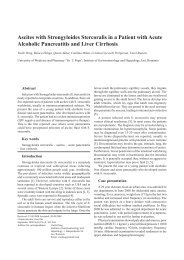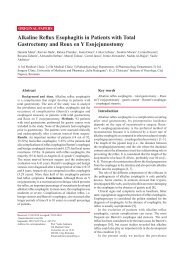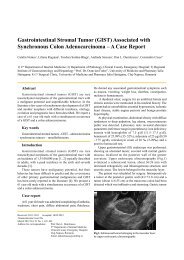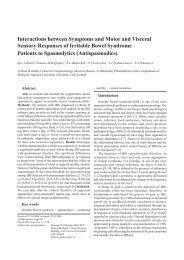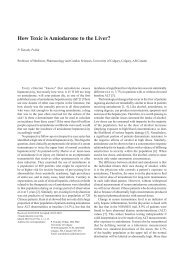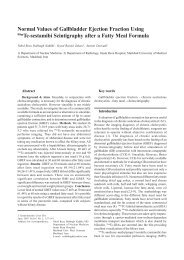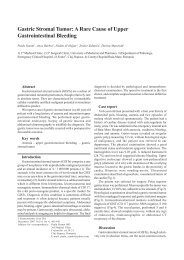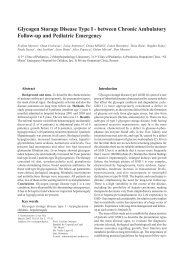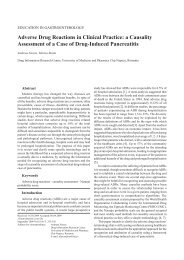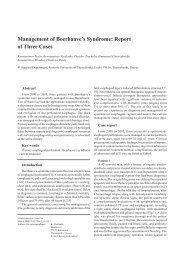Minimally Invasive Surgical Treatment of Morbid Obesity in Patients ...
Minimally Invasive Surgical Treatment of Morbid Obesity in Patients ...
Minimally Invasive Surgical Treatment of Morbid Obesity in Patients ...
Create successful ePaper yourself
Turn your PDF publications into a flip-book with our unique Google optimized e-Paper software.
M<strong>in</strong>imal <strong>in</strong>vasive surgery for morbid obesity<br />
<strong>M<strong>in</strong>imally</strong> <strong>Invasive</strong> <strong>Surgical</strong> <strong>Treatment</strong> <strong>of</strong> <strong>Morbid</strong> <strong>Obesity</strong><br />
<strong>in</strong> <strong>Patients</strong> with Specific Comorbidities. A Case Report<br />
Nicolae Constantea 1 , Dan Axente 1 , Dan Miclaus 1 , Vlad Dudric 1 , Flor<strong>in</strong> Jianu 1 , Constant<strong>in</strong> Bodolea 2<br />
1) 5 th <strong>Surgical</strong> Cl<strong>in</strong>ic. 2) Department <strong>of</strong> Intensive Care, Municipal University Hospital, Cluj-Napoca<br />
Abstract<br />
The mortality <strong>of</strong> patients with morbid obesity is 2 to 12<br />
times higher accord<strong>in</strong>g to age, comorbidities and the degree<br />
<strong>of</strong> obesity. <strong>Surgical</strong> treatment has proved to be the only<br />
type <strong>of</strong> treatment that has led to favorable long-term results.<br />
We present the therapeutic strategy used <strong>in</strong> a 39 year old<br />
obese patient with BMI=39.8 kg/m 2 , type 2 diabetes mellitus,<br />
arterial hypertension, severe hypercholesterolemia,<br />
nonalcoholic steatohepatitis and metabolic syndrome. The<br />
patient underwent laparoscopic gastric band<strong>in</strong>g with<br />
adjustable silicon band.<br />
Key words<br />
<strong>Morbid</strong> obesity - diabetes mellitus type 2 – laparoscopy<br />
- gastric band<strong>in</strong>g<br />
Introduction<br />
<strong>Obesity</strong> represents a major health issue that has reached<br />
epidemic proportions globally. Currently it accounts for 2-<br />
7.8% <strong>of</strong> total health care costs <strong>in</strong> developed countries.<br />
<strong>Morbid</strong> obesity is characterized by a body mass <strong>in</strong>dex<br />
(BMI) <strong>of</strong> 40kg/m 2 or higher. The follow<strong>in</strong>g contribute to the<br />
severity <strong>of</strong> this disease: the grow<strong>in</strong>g number <strong>of</strong> patients<br />
with morbid obesity, the occurrence <strong>of</strong> this pathology at<br />
<strong>in</strong>creas<strong>in</strong>gly younger ages and especially the severity <strong>of</strong><br />
specific comorbidities which severely <strong>in</strong>fluence the life<br />
expectancy <strong>of</strong> patients.<br />
Diet, physical exercise or medical therapy has not proved<br />
to be efficient <strong>in</strong> treat<strong>in</strong>g morbid obesity <strong>in</strong> the long term.<br />
Therefore, once laparoscopic surgical procedures were<br />
<strong>in</strong>troduced, the number <strong>of</strong> patients with morbid obesity who<br />
received surgical treatment <strong>in</strong>creased exponentially. The<br />
Roux -en-Y gastric bypass (RYGB) and gastric band<strong>in</strong>g (GB)<br />
J Gastro<strong>in</strong>test<strong>in</strong> Liver Dis<br />
December 2007 Vol.16 No 4, 449-451<br />
Address for correspondence: Dr.Nicolae Constantea MD<br />
5 th <strong>Surgical</strong> Cl<strong>in</strong>ic<br />
Tabacarilor Str., no.11<br />
Cluj-Napoca, Romania<br />
with adjustable silicon band are currently the most<br />
frequently used techniques (1).<br />
Recent metaanalyses on bariatric surgery outcomes<br />
revealed that <strong>in</strong> the long term, patients who underwent RYGB<br />
or GB lost 61.6% and 47.5%, respectively <strong>of</strong> excess body<br />
weight, while the complete resolution or improvement <strong>of</strong><br />
comorbidities were registered <strong>in</strong> most patients with type 2<br />
diabetes mellitus, hyperlipemia, hypertension, nonalcoholic<br />
steatohepatitis (NASH) and sleep apnea (1,2).<br />
Case report<br />
A 39 year-old female patient was admitted to our cl<strong>in</strong>ic<br />
on the 25 th <strong>of</strong> June 2007. She had already been registered at<br />
the Cl<strong>in</strong>ical Center for Diabetes, Nutrition and Metabolic<br />
Diseases, where she had been last admitted <strong>in</strong> March 2006<br />
and diagnosed with: <strong>in</strong>sul<strong>in</strong>-dependent type 2 diabetes<br />
mellitus, arterial hypertension, severe hypercholesterolemia,<br />
NASH, metabolic syndrome and class II obesity.<br />
The patient had had several hospital admissions to the<br />
3 rd Medical Cl<strong>in</strong>ic Cluj, where she was first diagnosed <strong>in</strong><br />
February 2004 with NASH based on laboratory, imag<strong>in</strong>g<br />
and histopathologic <strong>in</strong>vestigations after liver biopsy.<br />
She had had a history <strong>of</strong> <strong>in</strong>sul<strong>in</strong>-dependent type 2<br />
diabetes mellitus for 15 years. The patient received <strong>in</strong>sul<strong>in</strong>,<br />
hypotensive medication, silymar<strong>in</strong> and a hypocaloric diet.<br />
Her evolution was unfavorable, she ga<strong>in</strong>ed weight, the<br />
<strong>in</strong>sul<strong>in</strong> doses had to be <strong>in</strong>creased, glycemia was difficult to<br />
control, she had elevated blood pressure, altered hepatic<br />
function and the metabolic syndrome became more severe.<br />
The <strong>in</strong>vestigations carried out at that time revealed poor<br />
glycemic balance (HbA1c 10.2%).<br />
Given this evolution, the patient was referred to the 5 th<br />
<strong>Surgical</strong> Cl<strong>in</strong>ic for laparoscopic surgical treatment <strong>of</strong> obesity.<br />
On admission the patient had good general condition<br />
and BMI 39.8 kg/m 2 . She was be<strong>in</strong>g treated with Novorapid<br />
30 u and Lantus 70 u, plus hypotensive agents.<br />
The physical exam<strong>in</strong>ation <strong>in</strong>dicated lower body obesity<br />
with predom<strong>in</strong>antly abdom<strong>in</strong>al obesity, blood pressure 150/<br />
100 mmHg. Laboratory <strong>in</strong>vestigations: hyperglycemia 289<br />
mg/dl, hepatocytolysis AST 133 UI/l, ALT 69 UI/l, GGT 103
450<br />
UI/l, hypercholesterolemia 345 mg/dl, hypertriglyceridemia<br />
190 mg/dl, ESR 42 mm at 1 hour, hs–CRP 3.6 mg/dl. The<br />
other laboratory <strong>in</strong>vestigations, <strong>in</strong>clud<strong>in</strong>g thyroid hormones<br />
FT4 and TSH, were with<strong>in</strong> normal limits.<br />
The respiratory functional tests and the exam<strong>in</strong>ation <strong>of</strong><br />
the cardiac function <strong>in</strong>dicated normal values. The chest Xray<br />
revealed bilateral hilar <strong>in</strong>terstitial lung design. The patient<br />
had been smok<strong>in</strong>g 10-15 cigarettes a day for the last 10<br />
years.<br />
The abdom<strong>in</strong>al ultrasonography <strong>in</strong>dicated hepatomegaly<br />
(right lobe diameter 23 cm), hyperechogenic echostructure<br />
with posterior attenuation.<br />
Surgery was performed after brief preoperative<br />
preparations. Laparoscopic GB with adjustable silicon band,<br />
dra<strong>in</strong>age under the left diaphragm and under the left liver<br />
lobe were carried out (Fig.1).<br />
The postoperative evolution was favorable, <strong>in</strong>test<strong>in</strong>al<br />
transit was restored, the dra<strong>in</strong>s were removed, per oral<br />
feed<strong>in</strong>g was <strong>in</strong>itiated and <strong>in</strong>sul<strong>in</strong> therapy was re-<strong>in</strong>stituted.<br />
The postoperative x-ray <strong>of</strong> the esophagus, stomach and<br />
duodenum with Gastrograf<strong>in</strong> identified a correctly positioned<br />
band, proper evacuation through the band, reduced<br />
gastric peristalsis and normal transit <strong>in</strong> the duodenum.<br />
The patient was discharged on the 4th postoperative<br />
day. Adequate diet was prescribed at the Center for Diabetes,<br />
Nutrition and Metabolic Diseases.<br />
The surgical control performed 2 months postoperatively<br />
revealed a 7 kg weight loss, BMI <strong>of</strong> 37.3 kg/m 2 , decreased<br />
cholesterolemia (208 mg/dl) and triglyceridemia (160 mg/dl),<br />
lower transam<strong>in</strong>ase levels (AST 90 UI/l, ALT 59 UI/l, GGT 80<br />
UI/l), normal ESR values, hs–CRP 2.1 mg/dl. The <strong>in</strong>sul<strong>in</strong><br />
dose was also decreased from 30u <strong>of</strong> Novorapid to 10u,<br />
Lantus from 70 to 50u. Normal blood pressure values were<br />
registered under the <strong>in</strong>itial treatment.<br />
The gastric band was filled with 3 ml sal<strong>in</strong>e solution and<br />
the passage with contrast material was checked under<br />
radioscopic control.<br />
The surgical control at 4 months revealed a total body<br />
weight loss <strong>of</strong> 11 kg, BMI <strong>of</strong> 35.9 kg/m 2 , normal serum lipid<br />
levels, lower am<strong>in</strong>otransferase and GGT levels, hs–CRP 0.3<br />
mg/dl, cont<strong>in</strong>uous decrease <strong>of</strong> <strong>in</strong>sul<strong>in</strong> doses (Novorapid 5-<br />
10u, Lantus 30-35u) and normal blood pressure values under<br />
treatment.<br />
Fig.1 Position <strong>of</strong> gastric band dur<strong>in</strong>g surgery.<br />
Fig.2 Radiological control with contrast material <strong>of</strong><br />
band position and gastric passage.<br />
The fill<strong>in</strong>g <strong>of</strong> the gastric band under radioscopic control<br />
required an extra 3 ml sal<strong>in</strong>e solution; the passage was<br />
verified with contrast (Fig.2).<br />
The patient reported feel<strong>in</strong>gs <strong>of</strong> satiety after quantitatively<br />
reduced meals.<br />
Discussion<br />
Constantea et al<br />
Previously published studies have demonstrated the<br />
reduced efficiency <strong>of</strong> conservative treatment <strong>in</strong> the long<br />
term with only 5% <strong>of</strong> patients hav<strong>in</strong>g a normal weight, 5<br />
years after treatment <strong>in</strong>itiation. <strong>Surgical</strong> treatment has proved<br />
to be the only type <strong>of</strong> treatment that led to long-term<br />
favorable results. The laparoscopic approach and the<br />
assimilation <strong>of</strong> traditional techniques <strong>in</strong> laparoscopic surgery<br />
has strongly advocated the surgical treatment <strong>of</strong> morbid<br />
obesity, due to the obvious advantages <strong>of</strong> this surgical<br />
technique: postoperative comfort, lack <strong>of</strong> parietal<br />
complications, early <strong>in</strong>test<strong>in</strong>al transit, reduced dosis <strong>of</strong><br />
postoperative pa<strong>in</strong>-reliev<strong>in</strong>g medication, rapid social and<br />
pr<strong>of</strong>essional re<strong>in</strong>sertion. These are crucial advantages<br />
especially for patients with associated comorbidities and<br />
<strong>in</strong>creased anesthetic or surgical risk.<br />
Laparoscopic adjustable gastric band<strong>in</strong>g (LAGB) is<br />
currently the most frequently used procedure. This technique<br />
has proved to be safe. The available data <strong>in</strong>dicate a<br />
perioperative mortality <strong>of</strong> 0.05% and a complication rate <strong>of</strong><br />
2.6%, which is 10 fold lower than that registered <strong>in</strong> malabsorptive<br />
surgery (RYGB) (3).<br />
The long-term favorable evolution <strong>of</strong> patients who have<br />
underwent GB is also related to the possibility <strong>of</strong> adjust<strong>in</strong>g<br />
the gastric passage through the band by fill<strong>in</strong>g it with sal<strong>in</strong>e
M<strong>in</strong>imal <strong>in</strong>vasive surgery for morbid obesity 451<br />
solution or void<strong>in</strong>g it. The reversibility <strong>of</strong> the surgical<br />
<strong>in</strong>tervention is another advantage s<strong>in</strong>ce the band can also<br />
be removed laparoscopically.<br />
The long-term efficiency is reduced when compared with<br />
malabsorptive techniques, especially <strong>in</strong> cases <strong>of</strong> extreme<br />
obesity (BMI > 50 kg / m 2 ). Brown et al demonstrated an<br />
85% body weight loss, two years after LAGB <strong>in</strong> patients<br />
with BMI between 30 and 40 kg/m 2 (4). Postoperative<br />
nutritional deficiencies are less frequent <strong>in</strong> patients who<br />
undergo LAGB if a balanced diet is followed. The long-term<br />
disadvantages <strong>of</strong> this technique <strong>in</strong>clude the need for careful<br />
monitor<strong>in</strong>g <strong>of</strong> patient evolution, band adjustment, possible<br />
complications, band slippage, gastric wall erosion with<br />
<strong>in</strong>tralum<strong>in</strong>al migration, complications related to implant<strong>in</strong>g<br />
and secur<strong>in</strong>g the <strong>in</strong>jection port. However, such situations<br />
rarely occur when an adequate surgical technique is<br />
employed (5).<br />
<strong>Morbid</strong> obesity is associated with several specific<br />
comorbidities such as type 2 diabetes mellitus and <strong>in</strong>sul<strong>in</strong><br />
resistance, coronary heart disease, arterial hypertension,<br />
NASH, osteoarthritis, respiratory dysfunctions, etc. <strong>Morbid</strong><br />
obesity significantly decreases the life expectancy <strong>of</strong> young<br />
patients.<br />
Constant weight loss favors the remission <strong>of</strong> diabetes<br />
mellitus <strong>in</strong> two thirds <strong>of</strong> diabetic morbidly obese patients.<br />
This therapeutic effect is obvious especially if surgery is<br />
performed 1-2 years after diabetes is diagnosed (3).<br />
In our patient, the favorable evolution was proven by<br />
the halv<strong>in</strong>g <strong>of</strong> the <strong>in</strong>sul<strong>in</strong> dose required and stable glycemia<br />
levels, 4 months postoperatively.<br />
Nonalcoholic steatohepatitis <strong>in</strong> morbidly obese patients<br />
is signaled by <strong>in</strong>creased transam<strong>in</strong>ase and gamma-glutamyltransferase<br />
levels, <strong>in</strong>sul<strong>in</strong> resistance, hepatomegaly, hepatic<br />
steatosis as revealed by ultrasound exam<strong>in</strong>ation <strong>in</strong> patients<br />
who were not given hepatotoxic drugs or alcohol and had<br />
negative viral and autoimmune markers (6). It frequently<br />
occurs <strong>in</strong> comb<strong>in</strong>ation with metabolic syndrome<br />
components. Most studies <strong>in</strong>dicate that simple steatosis<br />
does not usually turn <strong>in</strong>to NASH or cirrhosis. On the other<br />
hand, 30-40% <strong>of</strong> NASH cases turn <strong>in</strong>to fibrosis over a 4year<br />
period. The risk factors for such an evolution <strong>in</strong>clude<br />
obesity, type 2 diabetes mellitus, <strong>in</strong>creased tranam<strong>in</strong>ase<br />
levels (AST/ALT >1) and age over 45 years (6,7).<br />
The therapy <strong>of</strong> NASH is usually targeted at the<br />
associated disorders: obesity, diabetes, dyslipidemia. A slow<br />
reduction <strong>in</strong> body weight (1.5 kg/week) proved efficient <strong>in</strong><br />
both reduc<strong>in</strong>g transam<strong>in</strong>ase levels, and improv<strong>in</strong>g histological<br />
liver changes (7). The liver ultrasonography carried<br />
out 2 and 4 months postoperatively did not detect changes<br />
as compared with the preoperative <strong>in</strong>vestigation.<br />
The metabolic syndrome is frequently associated with<br />
chronic <strong>in</strong>flammatory syndrome and coronary heart disease,<br />
demonstrated by the <strong>in</strong>flammatory biomarkers hs–CRP, IL-<br />
6 (8) and the assessment <strong>of</strong> the cardiac function (9,10). Body<br />
weight loss and the implicit decrease <strong>in</strong> <strong>in</strong>sul<strong>in</strong> resistance<br />
led to a significant reduction <strong>of</strong> the <strong>in</strong>flammatory bio-markers,<br />
<strong>in</strong> our patient. Regard<strong>in</strong>g cardiac func-tion, this patient had<br />
not ECG or echocardiographic signs <strong>of</strong> coronary heart<br />
disease prior to the surgical <strong>in</strong>tervention.<br />
Conclusions<br />
Surgery is currently the most efficient method <strong>of</strong> treat<strong>in</strong>g<br />
morbid obesity. It provides the best results as far as body<br />
weight loss and long-term evolution <strong>of</strong> specific comorbidities<br />
are concerned. The surgical laparoscopic techniques for<br />
morbid obesity have numerous advantages over traditional<br />
surgery. Gastric band<strong>in</strong>g is a restrictive procedure used <strong>in</strong><br />
laparoscopic surgery. The presence <strong>of</strong> comorbidities and<br />
their favorable evolution, accompanied by an <strong>in</strong>creased life<br />
expectancy after surgery represent additional arguments for<br />
choos<strong>in</strong>g surgical therapy.<br />
References<br />
1. Buchwald H, Avidor Y, Braunwald E, et al. Bariatric surgery: a<br />
systematic review and meta-analysis. JAMA 2004; 292:1724-<br />
1737.<br />
2. Shah M, Simha V, Garg A. Review: long-term impact <strong>of</strong> bariatric<br />
surgery on body weight, comorbidities, and nutritional status. J<br />
Cl<strong>in</strong> Endocr<strong>in</strong>ol Metab 91: 4223–4231.<br />
3. Brown W, Dixon JB, Brien PO. Management <strong>of</strong> obesity—the<br />
role <strong>of</strong> surgery. Aust Fam Physician 2006; 35: 584-586.<br />
4. Bowne WB, Julliard K, Castro AE, Shah P, Morgenthal CB,<br />
Ferzli GS. Laparoscopic gastric bypass is superior to adjustable<br />
gastric band <strong>in</strong> super morbidly obese patients. A prospective,<br />
comparative analysis. Arch Surg 2006 ; 141: 683-689.<br />
5. Mehanna MJ, Birjawi G, Moukaddam HA, Khoury G, Husse<strong>in</strong><br />
M, Al-Kutoubi A. Complications <strong>of</strong> adjustable gastric band<strong>in</strong>g,<br />
a radiological pictorial review. Am J Roentgenol 2006;186:<br />
522-534.<br />
6. Olteanu D, Olariu C. Diagnosticul creºterii cronice a<br />
transam<strong>in</strong>azelor, de cauzã obscurã. Rev Ed Med Cont Gastroent<br />
2004; 4:68-77.<br />
7. Adams LA, Angulo P. <strong>Treatment</strong> <strong>of</strong> non-alcoholic fatty liver<br />
disease. Postgrad Med J 2006; 82: 315–322.<br />
8. Kopp HP, Kopp CW, Festa A, et al. Impact <strong>of</strong> weight loss on<br />
<strong>in</strong>flammatory prote<strong>in</strong>s and their association with the <strong>in</strong>sul<strong>in</strong><br />
resistance syndrome <strong>in</strong> morbidly obese patients. Arterioscler<br />
Thromb Vasc Biol 2003; 23: 1042-1047.<br />
9. Leichman JG, Aguilar D, K<strong>in</strong>g TM, et al. Improvements <strong>in</strong><br />
systemic metabolism, anthropometrics and left ventricular<br />
geometry 3 months after bariatric surgery. Surg Obes Relat Dis<br />
2006; 2: 592–599.<br />
10. Fernstrom JD, Courcoulas AP, Houck PR, Fernstrom MH. Longterm<br />
changes <strong>in</strong> blood pressure <strong>in</strong> extremely obese patients<br />
who have undergone bariatric surgery. Arch Surg 2006;141:<br />
276-283.
Tarcoveanu et al
Titlu scurt<br />
QUIZ HQ 41<br />
Is any <strong>in</strong>trahepatic mass a tumor?<br />
A 56-year-old normoponderal woman with a crural hernia<br />
surgically cured 3 years before, was admitted <strong>in</strong> our unit for<br />
complete evaluation <strong>of</strong> an <strong>in</strong>trahepatic mass diagnosed at a<br />
rout<strong>in</strong>e ultrasound (US) performed <strong>in</strong> another unit and<br />
considered a neoplastic lesion. Medical history did not reveal<br />
chronic drug consumption or alcohol abuse. At admission,<br />
the patient was asymptomatic, with no compla<strong>in</strong>ts except<br />
moderate asthenia (no abdom<strong>in</strong>al pa<strong>in</strong>, weight loss, or fever).<br />
Physical exam<strong>in</strong>ation was normal, without hepatomegaly or<br />
spleen enlargement. Rout<strong>in</strong>e laboratory parameters did not<br />
show any pathological f<strong>in</strong>d<strong>in</strong>gs; serological screen<strong>in</strong>g for<br />
hepatic viruses B and C was negative; plasma cholesterol<br />
and triglycerides were <strong>in</strong> normal range and tumoral markers<br />
(alpha-foetoprote<strong>in</strong>, carc<strong>in</strong>oembrionic antigen, CA 19-9, CA<br />
125, CA 15-3) were with<strong>in</strong> normal limits as well. US revealed<br />
a normal liver size with a hyperechoic, <strong>in</strong>homogeneous mass,<br />
with irregular marg<strong>in</strong>s, <strong>in</strong>volv<strong>in</strong>g more than one half <strong>of</strong> the<br />
right hepatic lobe; Doppler exam<strong>in</strong>ation has shown a normal<br />
vascular pattern <strong>in</strong>side the hiperechoic mass (Figs. 1,2). The<br />
sonoelastographic exam<strong>in</strong>ation showed a low-medium<br />
stiffness <strong>of</strong> the hyperechoic mass (Fig.3).<br />
An extensive exam<strong>in</strong>ation compris<strong>in</strong>g upper and lower<br />
gastro<strong>in</strong>test<strong>in</strong>al endoscopy, X-Ray chest exam<strong>in</strong>ation and<br />
gynaecological exam was performed. The MRI confirmed<br />
the presence <strong>of</strong> a large <strong>in</strong>trahepatic mass located <strong>in</strong> the right<br />
hepatic lobe show<strong>in</strong>g hypocaptation <strong>of</strong> hepatocellular<br />
specific contrast agent and a huge amount <strong>of</strong> <strong>in</strong>tracellular<br />
fat accumulation; no vascular abnormalities were detected<br />
(Figs. 4,5). F<strong>in</strong>ally, an US-guided liver biopsy <strong>in</strong>to the<br />
suspected area was performed. The histological aspect <strong>of</strong><br />
the liver mass is depicted <strong>in</strong> Figs. 6-8.<br />
Question<br />
Fig.1Ultrasound exam<strong>in</strong>ation show<strong>in</strong>g a hyperecogenic<br />
<strong>in</strong>homogeneous area <strong>in</strong> the right hepatic lobe.<br />
What is the focal abnormality <strong>of</strong> the liver ?<br />
J Gastro<strong>in</strong>test<strong>in</strong> Liver Dis<br />
December 2007 Vol.16 No 4, 453-454<br />
Fig.2 Doppler exam<strong>in</strong>ation: normal vascular pattern<br />
and no mass effect.<br />
Fig.3 Elastogram: low-medium stiffness <strong>of</strong> the liver<br />
mass.<br />
Fig.4 Native MRI: the liver mass show<strong>in</strong>g hyposignal<br />
<strong>in</strong> T1.<br />
Fig.5 MRI washout phase: evidence <strong>of</strong> fat accumulation<br />
(“steatosis <strong>in</strong> geographic map”).
454<br />
Fig.6 Liver biopsy specimen: micro- and macrovezicular<br />
steatosis; a net demarcation between the fat<br />
area and the normal adjacent hepatic parenchyma (HE<br />
x40).<br />
References<br />
Iulia Simionov1 , Liana Gheorghe1 ,<br />
Gheorghe Becheanu1 , Ioana Lupescu2 1Center <strong>of</strong> Gastroenterology<br />
and Hepatology<br />
2Radiology Department<br />
Fundeni Cl<strong>in</strong>ical Institute<br />
Bucharest, Romania<br />
1. Brawer MK, Aust<strong>in</strong> GE, Lew<strong>in</strong> KJ. Focal fatty change <strong>of</strong> the<br />
liver, a poorly recognized entity. Gastroenterology 1980; 78:<br />
247-250<br />
Education <strong>in</strong> gastroenterology<br />
Fig.7 Liver biopsy specimen: grade 3 steatosis <strong>in</strong> the<br />
focal area (HE 400x).<br />
2. Mathiesen UL, Fransen LE, Aselius H et al. Increased liver<br />
echogenicity at ultrasound exam<strong>in</strong>ation reflects degree <strong>of</strong><br />
steatosis but not <strong>of</strong> fibrosis <strong>in</strong> asymptomatic patients with<br />
mild/moderate abnormalities <strong>of</strong> liver transam<strong>in</strong>ases. Dig Liver<br />
Dis 2002; 34: 516-522<br />
3. M. Lupsor, R. Badea. Imag<strong>in</strong>g diagnosis and quantification <strong>of</strong><br />
hepatic steatosis: is it an accepted alternative to needle biopsy.<br />
Rom J Gastroenterol 2005; 14: 419-425<br />
4. Siegelman ES, Rosen MA. Imag<strong>in</strong>g <strong>of</strong> hepatic steatosis. Sem<strong>in</strong><br />
Liver Dis 2001; 21:71-80.<br />
5. Fishbe<strong>in</strong> M, Castro F, Sailaja C, et al. Hepatic MRI for fat<br />
quantitation: its relationship to fat morphology, diagnosis and<br />
ultrasound. J Cl<strong>in</strong> Gastroenterol 2005; 39: 619-625




